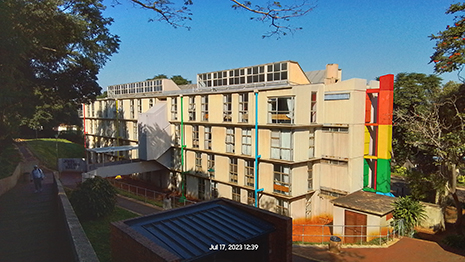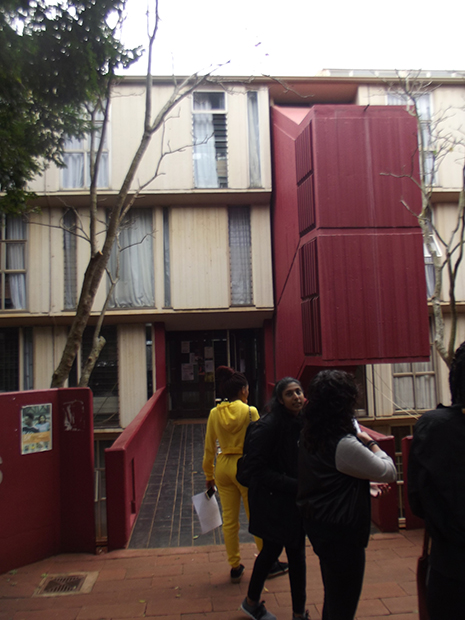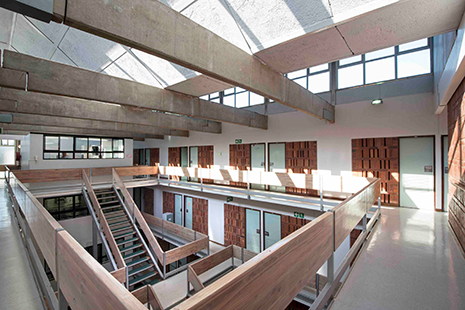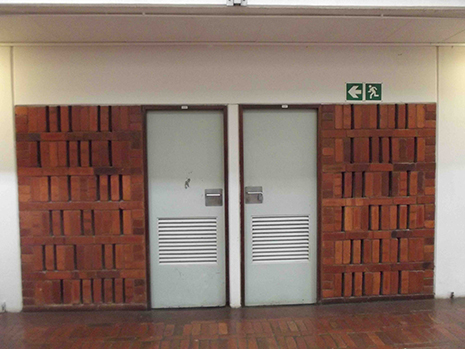Description
Built by architects Hallen, Dibb & Partners (architect of record: Hans Hallen), the John Bews Hall of Residence (1964) was designed together with Mabel Palmer Hall of Residence (1965) and Scully Dining Hall (1966) in a unified, stylistic idiom of “romantic” Brutalism (Greig, 1971, p. 113). They display strong geometric forms, a palette of austere, off-shutter concrete and facebrick, and timber screens and railings, with lightweight aluminium adjustable-louvre glazing. Perhaps surprising, the apartheid state in South Africa embraced the Modern Movement, and Brutalism in particular, with its raw, muscular display of concrete and the textural earthiness of clay-tiling and facebrick. Using this idiom, Hans Hallen achieved a landscaped ensemble with structurally bold and highly adventuresome interiors for the delight of the students.
Programmatically, the halls reflected an English “Oxbridge” influence, where privileged white students could study and live sociably, and eat together, wearing formal academic gowns. Sixty years on, the student population is racially diverse, the dining hall has become a gymnasium and the raw concrete surfaces are brightly painted.
In concept, each hall is centred around its own atrium. Geometrically, however, the spatial planning and cross-sections of each building could not be more diverse. Stylistically ⎯ in their monumentality and interior manipulation of light ⎯ the inspiration by Louis Kahn is evident. But the style here is more playful and less solemn, with circulation bridges, skylights and multi-tiered levels activating movement and views throughout. Functionally, the multi-storeyed atrium, as a typological form, aids cross-ventilation, reduces humidity and modifies heat gain.
The halls were intended to be appreciated three-dimensionally, as a set of “monumental sculptures” in a densely vegetated coastal sub-tropical landscape. Hillside terrain and coastal bushland dominate the campus setting. The daily circulation, when students return on foot from the hilltop lectures and libraries to the halls of residence, is downhill, with a sequence of partial views of façades and roofscapes, cloaked in vegetation. Walking along a network of ramped footpaths, seated forecourts and terraced stairways, the impact of gravity is lessened by manipulation of steep contours around and views between structures, and by directional shifts in movement routes up and down the slope. Hallen’s campus grouping has been likened to “spotting rhinoceroses … glimpsed amongst the foliage”. (Fisher and Clarke, 2014, p. 64).
The first of the ensemble to be built, John Bews (1964) is a four-storey linear block, cantilevered outwards and cast in ribbed concrete. Fenestration stretches from floor-to-ceiling. Mid-level entry to the hall, across a suspended concrete bridge, brings one into the dominant central atrium, split in half by common rooms for each floor, and banks of student rooms to either side.
Skylights above fill the interior with daylight. Slender, transverse concrete beams tie back the cantilevers. Circulation is provided by concrete stairs hanging centrally in the atria. The ribbed off-shutter concrete exterior (i. e. in-situ concrete bearing marks from the formwork) was painted in 2019 and new aluminium windows replaced the original adjustable louvres.
References
Fisher, R. and Clarke, N. (2014). Architectural Guide: South Africa. Berlin: DOM Publishers.
Greig, D. (1971). A guide to Architecture in South Africa. Cape Town: Howard Timmins.
Mungroo, M. (2016). Renowned Architect Hans Hallen visits UKZN Residences. In: UKZNABA online vol.4(24), 26 May 2016.
 Exterior view: the original exposed concrete façade was painted over.
Exterior view: the original exposed concrete façade was painted over.
 View of entrance bridge
View of entrance bridge
 Atrium and central staircase with precast concrete tie beams
Atrium and central staircase with precast concrete tie beams
 Detail of facebrick corridors
Detail of facebrick corridors
Originally published in: Uta Pottgiesser, Ana Tostões, Modernism in Africa. The Architecture of Angola, Ghana, Mozambique, Nigeria, Rwanda, South Africa, Sudan, Tanzania, Uganda, Birkhäuser, 2024.